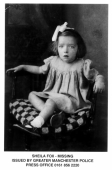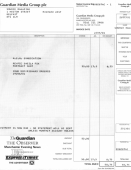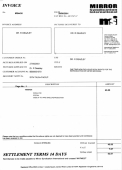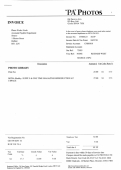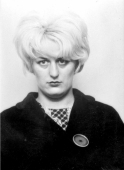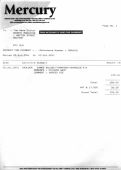Collecting photographs, copyrights and cash
Ronan Deazley looks into the saleability of some ‘public interest’ photographs. From The Source Photographic Review
On Wednesday 6 June 2001 all of the mainstream British press (with the exception ofThe Daily Telegraph) carried a story about ‘a six-year-old girl with pink ribbons in her hair’ who disappeared on a 200-yard walk home from her local primary school. The girl’s name was Sheila Fox. She had disappeared 57 years earlier in August 1944 and was now re-entering the public consciousness in 2001 as a result of the Manchester Police re-opening the case following fresh eyewitness evidence. On 5 June they began digging for her body in the back garden of a semi-detached house that she had passed every day on her journey to and from school. This article is about Sheila’s photograph, and the images of the other children who, every year, make national headlines for the wrong reasons. While each of these children’s stories is particular, they share the common tragedy that comes with the unnecessary and unexpected loss of a young life. Their stories become rooted deep in the public consciousness. So too do their faces. Sarah Payne. Damilola Taylor. Jamie Bulger. Each name brings to mind a corresponding image. The same can be said, not just for the victims of such crimes, but also for the perpetrators. We all know what Myra Hindley looks like, or at least what she looked like over thirty-five years ago at the time of the Moors Murders. Similarly for Ian Brady, Harold Shipman, Lenny Murphy or Fred West. Victim and offender alike are frozen in our visual memory.
These photographs, be they family snapshot, school photograph or police mug shot, are commonly referred to by the press as collect photographs, that is, photographs that are not taken by press photographers themselves but are rather collected from the family home, from the police press office or from other undisclosed sources. Newspapers and press agencies will often claim exclusive rights to the reproduction of these photographs. It is this trade in these images that provides the focus for this article.
Sheila Fox (aged three)
Accompanying the press coverage of this story was a portrait, probably taken professionally, of Sheila aged three, which featured in most of the national papers. Upon contacting the syndication departments of The Sun and The Guardian I was informed that I should approach the Manchester Evening News (MEN) about reproduction rights. Similarly The Times, The Daily Express and The Daily Mail all told me that the MEN held the copyright in the image. Upon speaking with the MEN (part of the Guardian Media Group) they confirmed that they had indeed released the photograph to the national press on the evening of 5 June for which they charged not a copyright fee (as they did not have the copyright in the image) but rather a wire fee for physically sending the image (via email) to each of the major newspapers. By the same account, should I want to reproduce the photograph, they would send it to me (via email) for a similar wire fee of £50.
Of the national press, only The Mirror did not redirect me to theMEN. Instead, their syndication department informed me that the photograph in question was in fact a Mirror photograph (Reference: CD 1986258), that they held the syndication rights to the image and that they would charge a copyright fee (a one time non-exclusive book right) for its commercial reproduction (£45 for a quarter page single reproduction).
Upon speaking with the Greater Manchester Police Press Office however, it transpired that Sheila’s sister had provided the Press Office with the photograph in question on the day that the Manchester Police began to dig for Sheila’s body. On that day, the 5 June, the Press Office had made the image available to the local and national press (both the MEN and the Mirror had ‘collected’ the image from a police press officer at the site of the dig). The Press Office provided me with the image that they released to the press. Upon the back of the photograph was their standard legal notice accompanying the release of all such material. The notice reads: ‘This document is being released to you for the purpose of reporting this particular case/incident. Its use thereafter is not sanctioned by Greater Manchester Police without the direct authority of the Chief Constable who retains the copyright.
Thompson, Venables, Hindley (to name but a few)
The actions of the Manchester Police in re-opening the unsolved case of Sheila Fox generated what many would consider to be an unwelcome and somewhat distasteful by-product: a trade in Sheila’s image. Such transactions however are by no means limited to the victims of crime. Perhaps no other crime of late has rocked the public consciousness more than the murder of Jamie Bulger. Shocking not only due to the callous and premeditated brutality of the murder, but also to the fact that the two perpetrators of the crime, Robert Thompson and Jon Venables, were aged only ten at the time of Jamie’s death. We can see them both, smiling for a school photographer and more recently, scared, holding boards bearing their name and the date of their arrest by the Merseyside Police, the 18 February 1993. When approached, all the major newspapers indicated that Mercury Press, an independent picture agency, held the copyright in all four of these images. This was confirmed by Mercury themselves who were happy to chargeSource magazine £75 for the commercial reproduction of each image.
While the fate of Jamie Bulger is perhaps the most tragic of recent times, that of the children who lost their lives to Ian Brady and Myra Hindley remains arguably the most notorious. Convicted in 1966 for the murders of Lesley Ann Downey, John Kilbride and Edward Evans, the story of their crime remains no less sensational today than it was over thirty-five years ago. For the first time in British history a women was involved in a criminal partnership that engaged in the serial, sexual murder of innocent children and teenagers. The police mug shots of these two, paraded before the public eye time and time again, seem to epitomise all that can be wrong with our society. Their photographs, and particularly that of Hindley, have been imbued with an iconic, if demonic, significance. Where Thompson and Venables belong to Mercury Press, Brady and Hindley belong either to the Press Association (available for reproduction for anything between £20 and £232 depending upon the use of the image and the size of the commercial print run), or, alternatively to Corbis who are willing to authorise the use of the picture for a modest £60.
Collect photographs and copyright
Why is it that the Manchester Evening News feel able to charge a £50 wire fee for an image of a missing child that they received, and is still freely available, from the Manchester Police Press Office? How is it that Mirror Syndication International can claim exclusive syndication rights in a photograph for which the Chief Constable of the Greater Manchester Police asserts copyright control? Do the school photographs and police mug shots of Thompson and Venables actually belong to Mercury Press? Is it the Press Association or Corbis that holds the exclusive rights to Hindley? Is it either? That newspapers and press agencies should lay claim to the exclusive right to charge for the reproduction of such collect photographs gives pause for thought.
Copyright, currently regulated by the Copyright Designs and Patents Act 1988 (the CDPA) (as amended), is an intangible property right that provides the owner with the ability to commercially exploit the reproduction of his or her work by preventing others from doing the same. Those responsible for collecting the physical photograph generally rest their claim upon the fact that when the photograph is handed over so too are the rights to commercially reproduce the photograph. That is, the delivery of the physical photograph and the delivery of the copyright in the photograph go hand in hand. As a concept, and as an argument for exclusive control over the commercial reproduction of the photograph, this is misplaced. To accept such a premise is to misunderstand one of the most fundamental principles of copyright law. Ownership of the physical work, be it a photograph or a painting, does not mean that you will necessarily own the copyright in the work. In the same way, ownership of the copyright in a work does not mean that you necessarily own the work itself. They are two separate and identifiable forms of property, each capable of being owned by two separate and identifiable parties.
This distinction between the physical photograph and the intangible copyright in a photograph gives rise to two related issues for consideration. When a photograph is simply collected, the journalist in question has, most probably, been in contact with the person who owns the physical photograph. He or she may not however have had any dealing with the owner of the copyright in the photograph. The question of who actually owns the copyright in the photograph is then obviously paramount. Second, even if the journalist is dealing with the owner of the copyright in the photograph, one needs to consider the nature of the action between the two. What are the legal implications (if any) of the transaction between the owner of the copyright and the collector? Have any rights in the photograph changed hands at all?
Authorship and ownership
Ownership of copyright in a work is intimately linked with the authorship of the work. In general the author of a photograph (that is, the person who creates it) will be the first owner of the copyright in that photograph (CDPA, s.11(1)). This remains unproblematic for the collector where the photograph is a family snapshot and, potentially, the owner and author of the photograph are one and the same person. Consider however the school photographs of Thompson or Venables. They provide a perfect example of the ownership of the photograph and the ownership of the copyright in the photograph resting in two different hands. While the parent owns the physical photograph, the school photographer retains the copyright in the picture. Unless Mercury Press have approached the photographer in question then they actually have no more right to reproduce the photograph, nor to authorise or indeed prevent reproduction by others, than you or I.
Consider the mug shots of Thompson and Venables. The individual police officer responsible for each picture is indeed the author of the photograph. In this case however, this does not mean that he or she will own the copyright in the photograph. Contrary to the usual rule (CDPA, s.11(1)), where the photograph has been taken by someone in the course of a contract of employment, it will be the employer who will own the copyright in the employee’s work (CDPA, s.11(2)) (subject that is to any prior agreement between the two). Consequently, however any given mug shot should end up in the hands of a national newspaper, or picture agency, unless they have been dealing with the respective Chief Constable in question, then they have not been dealing with the copyright owner.
The photographs of Hindley or Brady present a slightly different scenario. Taken at a time when the law was governed by the Copyright Act 1956, the first ownership of the copyright in a photograph was, as is the case today, deemed to reside with the author of the photograph. The earlier act differed however in providing that the author of a photograph be defined as the proprietor of the materials upon which the photograph was made (not necessarily the person who creates the photograph). Different legislation but the same result. The copyright in the police mug shots would lie with the person with ultimate responsibility for the camera and film used in taking the pictures, in this case, presumably, the Chief Superintendent of the Cheshire C.I.D at the time of the Moors murders.
Legal and equitable assignment
Presume for a moment that when all of these images are collected they are in fact collected from the person who owns the copyright in the photograph. Even if this is the case, then the nature of the transaction between the copyright owner and collector requires some thought. The owner of the copyright in any given work can, in general, do one of two things with the property. They can assign the copyright in the work to another person in which case they cease to have any further interest in the copyright work at all. Alternatively, they can licence the use of the work by another (for certain specified purposes). In this instance they still retain the copyright in the work but cannot legally complain against the licensee who makes such use of the copyright work as is allowed by the agreed licence. When photographs are collected from their copyright owners, does the exchange between the parties more often take the form of an assignment of the copyright, or of a licence to make use of the work?
Consider the first of these two options: the assignment. An assignment of copyright will only occur in two specific situations. First, if the transaction takes place in accordance with the requirements of the current legislation, that is, that it takes place in writing and is signed by the copyright owner (CDPA, s.90(3)). Given the circumstances in which such photographs are collected it is unlikely that any written transaction occurs at all. It seems improbable, for example, that the Chief Constable of the Mersyside Police assigned, in writing, any copyright in the mug shot of Robert Thompson to Mercury Press. Few, if any, of these collect scenarios will involve any form of written agreement at all.
If there is no form of written agreement between the two parties that still leaves open the possibility of what is referred to as an equitable assignment of the copyright in the work. In this case the parties must have agreed to assign the copyright in the photograph, for good consideration (generally, money), but have simply failed to satisfy the statutory requirements for such assignment (that is, that it be in writing and signed by the copyright owner). In such circumstances the person collecting the picture may, in theory, acquire what is called the equitable title to the copyright work. Such an explanation however appears rather implausible. Whether the photograph is being collected from the family or friend of a victim (or offender), it remains unlikely that the person handing over the photograph has even begun to think about the copyright implications of the exchange, never mind intending to assign the copyright to the collector, nor indeed, asking for or receiving anything in return. In such situations they probably intend no more than to simply get rid of the journalist on their doorstep.
Exclusive and implied licences
If the copyright in the photograph is not being assigned then, at most, the people collecting such pictures can argue that they are being granted a licence to reproduce the image. A licence to use a copyright work differs from an assignment of that copyright work in one important respect. In the granting of a licence, no proprietary interest whatsoever passes to the licensee. There is no exchange of property here. Rather the licence simply makes lawful that which would otherwise be unlawful. If such a licence exists between the owner of the copyright in the photograph and the person who has collected the photograph then at its most basic it will simply ensure that the licensee (the collector) is allowed to reproduce the photograph with impunity.
As is the case with assignments there are two different types of licence to consider: the exclusive licence, and the implied or informal licence. An exclusive licence guarantees the licensee the ability to exercise a right (such as the commercial reproduction of the work) which would otherwise be exercisable only by the copyright owner. Such a licence is effective against all other persons including the copyright owner. The exclusive licence however, like the legal assignment, must be in writing and signed by (or on behalf of) the copyright owner (CDPA, s.92 (1)). For the reasons outlined above, such written transactions appear doubtful.
Having ruled out legal and equitable assignments, as well as the exclusive licence, this means that, when the photograph is simply handed over to the enquiring member of the press, at best, they will be able to argue that they have an implied or informal licence. Such licences can be oral, can be gratuitous and can be inferred from the conduct of the parties involved. What is actually authorised by such a licence however remains open for conjecture. At the very least the collector (the licensee) will have been authorised to reproduce the picture in question without threat of legal action from the copyright owner. Whether or not the informal licence will extend to authorising the licensee to sub-licence the use of the image is questionable (consider the notice attached by the Manchester Press Office to the photograph of Sheila Fox). Indeed it may be that by even attempting to further licence the reproduction of the photograph to other newspapers or press agencies, then the licensee is actually acting in breach of the initial licence with the result that they may in fact forfeit any rights to reproduce the picture themselves.
A further point, and perhaps most importantly for those agencies or individuals claiming provenance over any collect photograph, is that should anyone else reproduce the picture without prior authorisation, there is little that the collector can do about it. When a licence is granted, the licensee has no right to bring an action in his or her own name. That privilege remains with the copyright owner alone (or in certain circumstances with the exclusive licensee). Should I reprint the Hindley photograph there would seem to be little that the Press Association or Corbis can actually do without enjoining the true owner of the copyright in the photograph in the legal action.
Sympathy or vilification, but always cash
When the member of staff from the Press Association confidently assures you that, yes, they do own the rights to the Myra Hindley photograph, one wonders whether that can be entirely true. Did the Chief Superintendent of the Cheshire C.I.D. really assign the copyright in the Hindley mug shot to a commercial picture agency? Upon what basis is Mercury Press claiming legal provenance of pictures taken by a Merseyside police photographer on 18 February 1993? Are such claims based upon an accurate understanding of the copyright regime, or upon the fact that the journalist in question was the first to take physical possession of a commercially lucrative photograph? Legally speaking, what claims these press agencies and newspapers may make to control and authorise the reproduction of collect photographs are on a less than certain footing. The issues generated by questions of the authorship, ownership, assignment and licensing of copyrights expose such assertions of exclusive control and syndication rights as ill-conceived and unsupportable. This is an industry that thrives upon the bluff and bravado of those collecting the photographs and the legal ignorance of those others wishing to make use of such images.
More objectionable however, than these spurious assertions of copyright control, is the very fact that such images should be reduced to the level of commerce at all. How many times in the last thirty-five years has Hindley’s image been paraded before the public? How often have you been presented with Thompson and Venables in the last eight years, or even in the last eight weeks? How much money has already changed hands on account of the missing Sheila Fox? The press, writ large, find it in their hearts to rail angrily against the prospect of Myra Hindley ever being released from prison, and ominously decry the too-early release of Thompson and Venables having served only eight years for the murder of Jamie Bulger (‘Bulger killers better off dead’ proclaim the Daily Star; ‘Bulger killer dead in four weeks’ predict the News of the World). They quickly condemn the actions of that other most modern of malcontents, the paedophile, threatening exposure, and promising retribution, so that our children can live free from the threat of violence and abuse. Such rampant moral indignation, so powerful in mobilising public opinion, strikes a rather hollow chord. The claims of the press to champion the interests of the innocent, of the victims, of justice, appears compromised when one realises that, after all is said and done, the protagonists of these tragic stories, be they child or adult, victim or offender, are all equally subject to the same process of commercial exploitation.
Ultimately, drawing upon a faithful reading of the law of copyright seems a rather crude and unsatisfactory method for discussing the broader issues raised by the use the press makes of these collect photographs. Such narrow legal parameters hardly provide a suitable forum for addressing the differing interests of the various parties involved. How are the interests of the victims and their families best served throughout? How appropriate is the use made of the images of offenders and alleged offenders? Does it serve to improve or exacerbate their chances of receiving a fair and just trial? Will it jeopardise any meaningful opportunity for their rehabilitation or reintegration into society? An accurate understanding of copyright law will not go far towards tackling these broader ethical dilemmas. Nevertheless, it does serve some purpose, if only to call into question the illicit and insensitive profiteering and trade, in which the press indulges, in the collect photographs of offender and victim alike.




